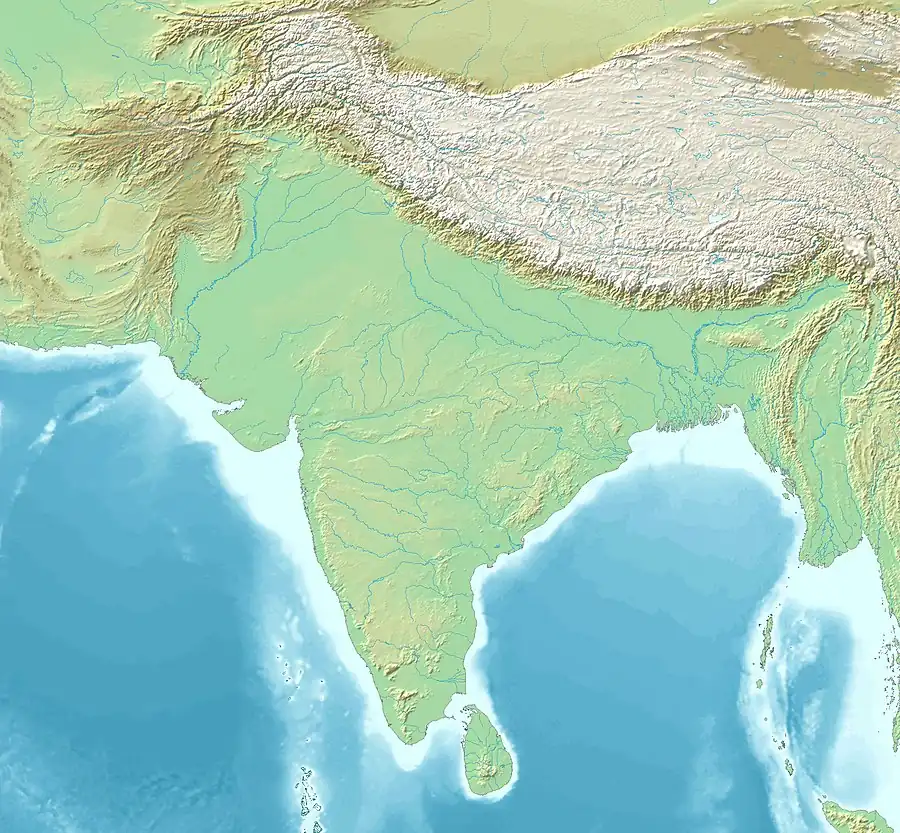Davaka kingdom
Davaka was a kingdom of ancient Indian subcontinent, located in current central region of Assam state.[2] The references to it comes from the 4th century Allahabad pillar inscription of Samudragupta, where it is mentioned as one of five frontier kingdoms of the Gupta Empire.[3]

| Part of a series on the |
| History of Assam |
|---|
 |
| Categories |
|
| Part of a series on the |
| Culture of Assam |
|---|
 |
Davaka Kingdom | |
|---|---|
| ??–6th century CE | |
 South Asia 350 CE ◁ ▷ Location on the Davaka kingdom and contemporary South Asian polities circa 350 CE.[1] | |
| Capital | Unknown and Lanka |
| Historical era | Classical Period |
• Established | ?? |
• Disestablished | 6th century CE |
| Today part of | India |
Other references are the Shung-Shu History of the Liu Song dynasty, where the kingdom is named Kapili (now the name of a river); the Gachtal stone pillar inscription written in Kamrupi Prakrit.[7][8] N. K. Bhattasali has identified it with Dabaka in modern Hojai district, with the kingdom associated with the Kopili-Kolong river valley.[9][10]
Historians such as B. N. Puri (1968) and P. C. Choudhury (1959) claim that it was absorbed much earlier in the first half of the 5th century during the reign of Kalyana Varman (422–446).[11][12]
Its capital was located near Kopili river. In the year 428 AD, an ambassador was sent to China by Davaka king, whose name according to Chinese sources is Yuegnai or Yu Chai.[13]
Gatchal Stone Pillar inscription mention that the Yavana(Muslim) crossed the boundary to move east to reach Davaka in 1362 (saka 1284). A river (identified as Yamuna) that floods during April-May helped naval forces to drive away enemies.[14]
See also
References
- Schwartzberg, Joseph E. (1978). A Historical atlas of South Asia. Chicago: University of Chicago Press. p. 145, map XIV.1 (d). ISBN 0226742210.
- Suresh Kant Sharma, Usha Sharma (2005), Discovery of North-East India: Geography, History, Culture, ..., Davaka (Nowgong) and Kamarupa as separate and submissive friendly kingdoms
- Samatata- Davaka- Kamarupa - Nepala - Kartripura Pratyanta Nrpatibhir
- "639 Identifier Documentation: aho – ISO 639-3". SIL International (formerly known as the Summer Institute of Linguistics). SIL International. Retrieved 29 June 2019.
Ahom [aho]
- "Population by Religious Communities". Census India – 2001. Ministry of Home Affairs, Government of India. Retrieved 1 July 2019.
Census Data Finder/C Series/Population by Religious Communities
- "Population by religion community – 2011". Census of India, 2011. The Registrar General & Census Commissioner, India. Archived from the original on 25 August 2015.
2011census/C-01/DDW00C-01 MDDS.XLS
- identified with the Davaka region of Nagaon district of Assam, the location of which, can be confirmed by the Gachtal stone pillar inscription.6 The Allahabad stone pillar inscription of Samudragupta mentions Davaka along with Samatata (Boruah 2001:136)
- Kamrupi inscriptions associated with the Kamarupa kingdom give an estimate of its geographical location and extent.(Lahiri 1991:26–28)
- (Mookerji 1973, p. 24)
- (Dutta 2008:53)
- "As regards the eastern limits of the kingdom, Davaka was absorbed within Kamarupa under Kalyanavarman and the outlying regions were brought under subjugation by Mahendravarman." (Choudhury 1959, p. 47)
- "It is presumed that (Kalyana Varman) conquered Davaka, incorporating it within the kingdom of Kamarupa" (Puri 1968, p. 11)
- Besides these, the Chinese source clearly mentioned that the mission was sent by a king called Yueh-ai of the Kapili state whose capital city lies close to the Heng-ho or Ka- pi-li-ho river.(Boruah 2001:138)
- (Boruah 2001:136–137)
Bibliography
- Boruah, Nirode (2001). "The kingdom of the Kapili Valley of Assam". Proceedings of the Indian History Congress. 62: 135–143. ISSN 2249-1937. JSTOR 44155755.
- Choudhury, P. C. (1959). The History of Civilization of the People of Assam to the Twelfth Century AD. Department of History and Antiquarian Studies, Gauhati, Assam.
- Dutta, Anima (2008). Political geography of Pragjyotisa Kamarupa (Ph.D.). Gauhati University. hdl:10603/68309.
- Lahiri, Nayanjot (1991). Pre-Ahom Assam: Studies in the Inscriptions of Assam between the Fifth and the Thirteenth Centuries AD. Delhi: Munshiram Manoharlal Publishers Pvt Ltd.
- Puri, Brij Nath (1968). Studies in Early History and Administration in Assam. Gauhati University.
- Mookerji, Radhakumud (1973). The Gupta Empire. Motilal Banarasidass.
- Sharma, M M (1990), "Language and Literature", in Barpujari, H K (ed.), The Comprehensive History of Assam, vol. I, Guwahati: Publication Board, Assam, pp. 263–264